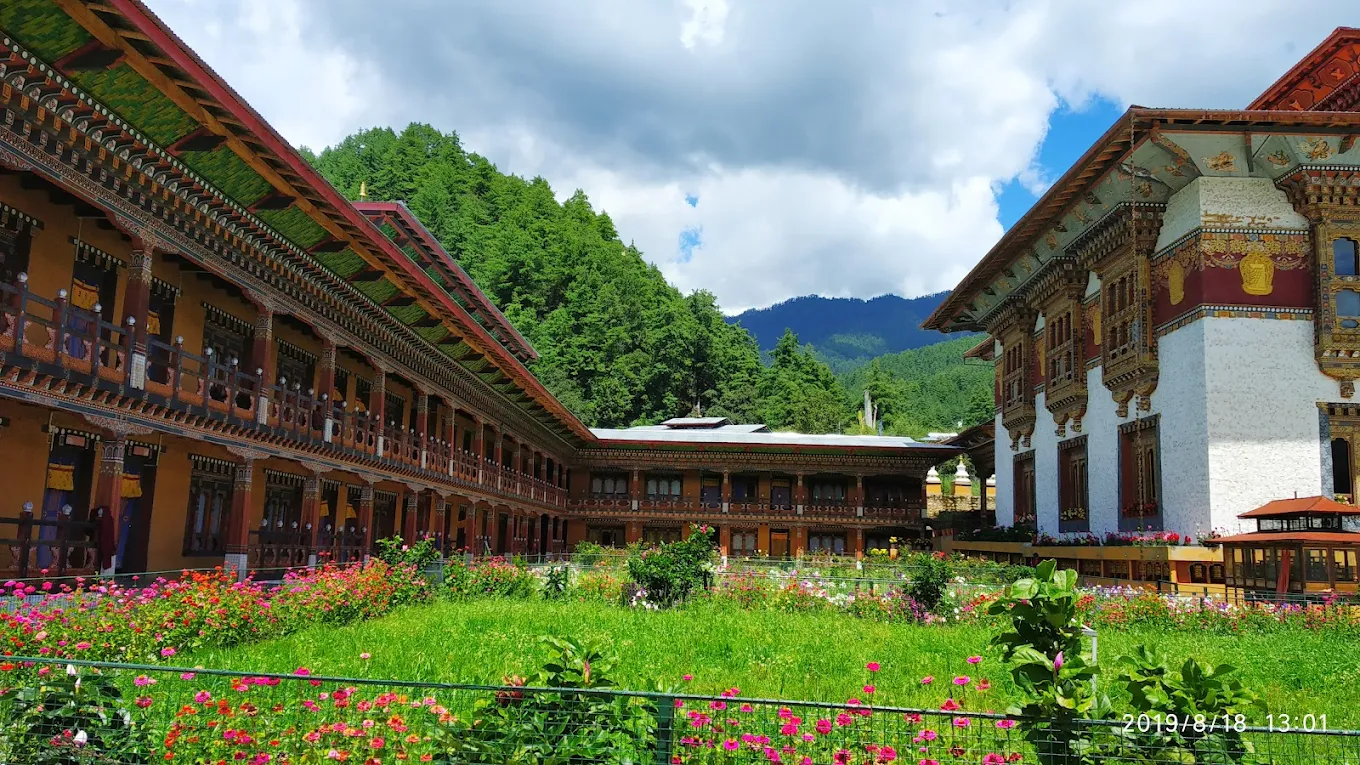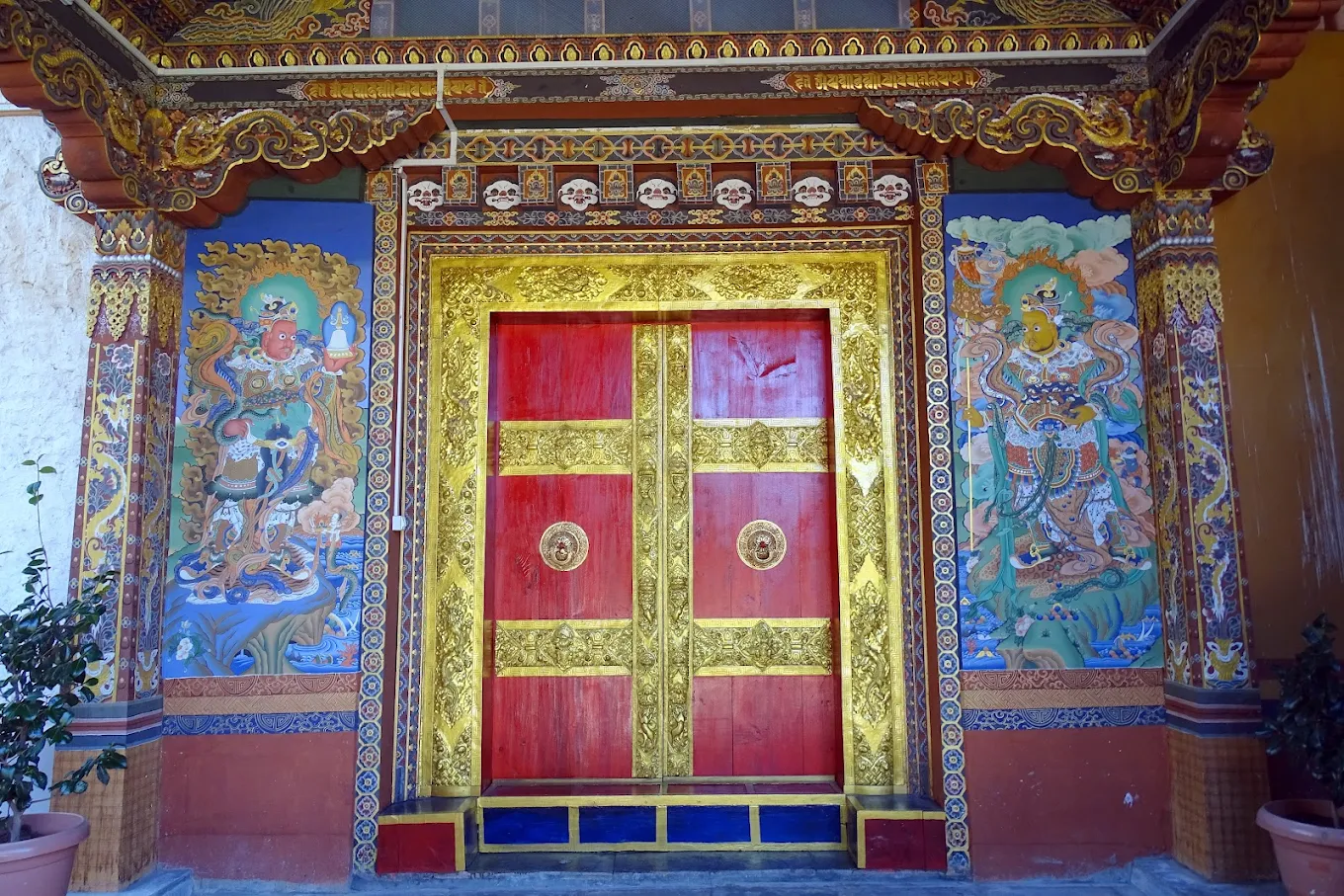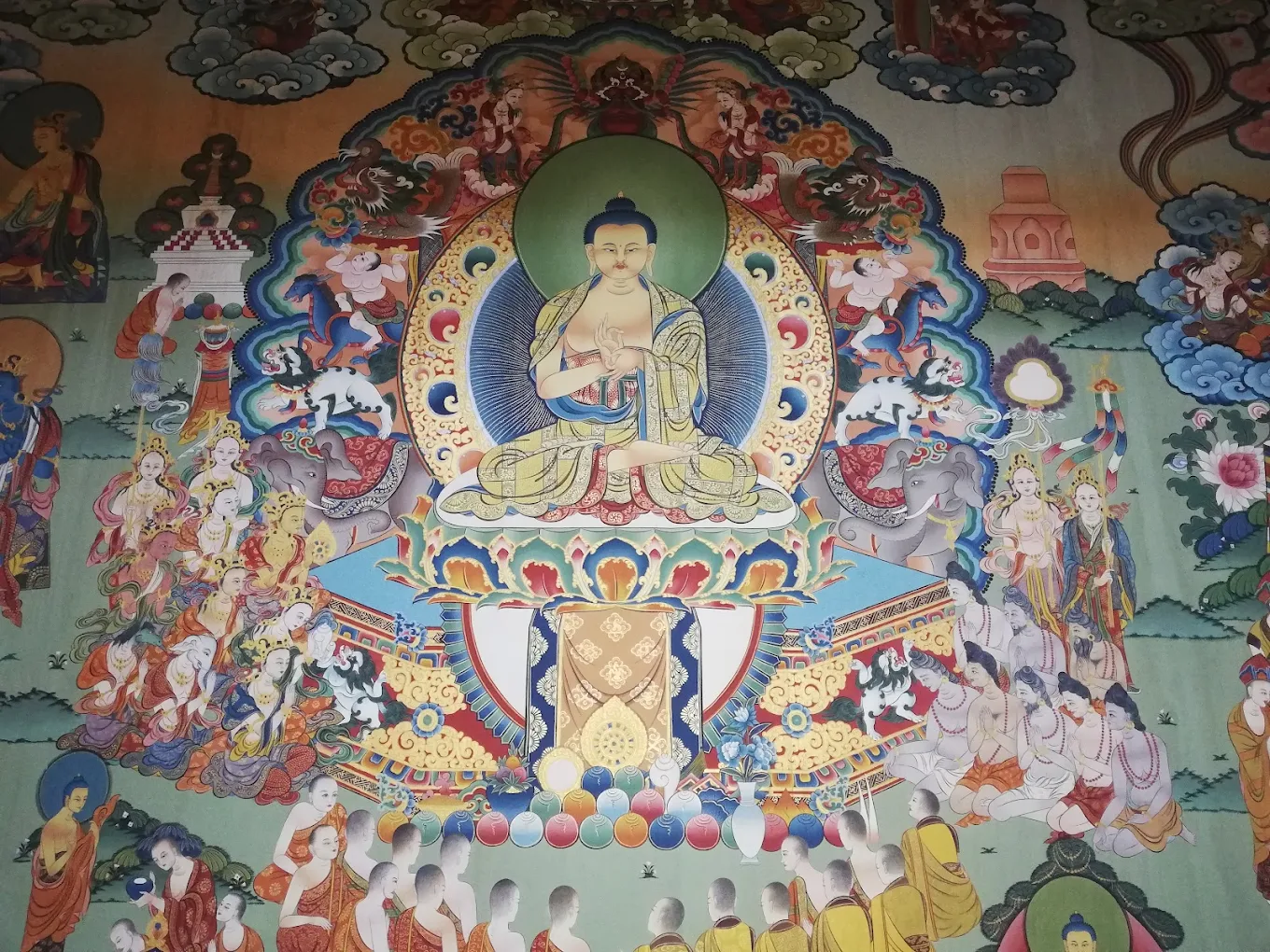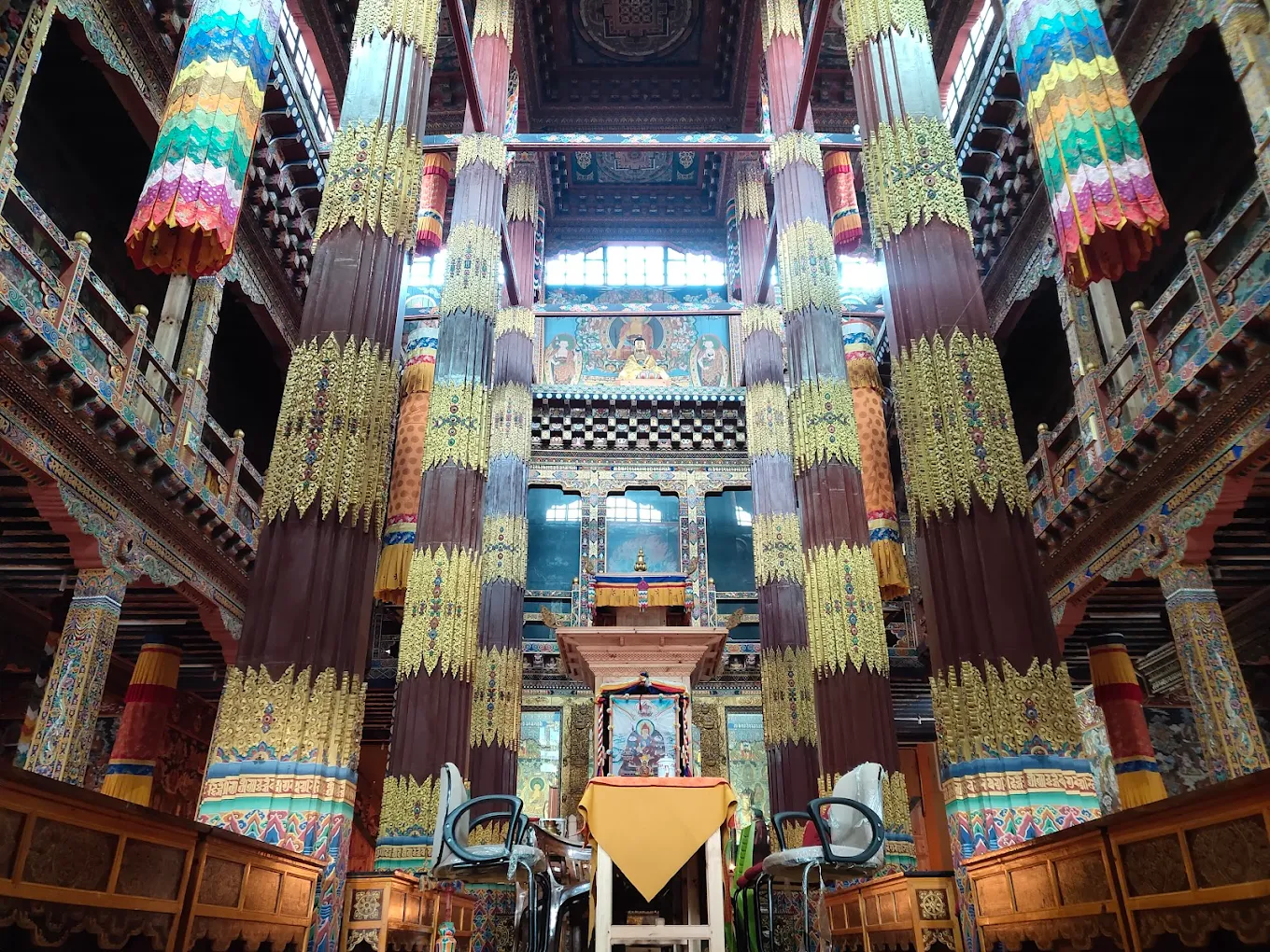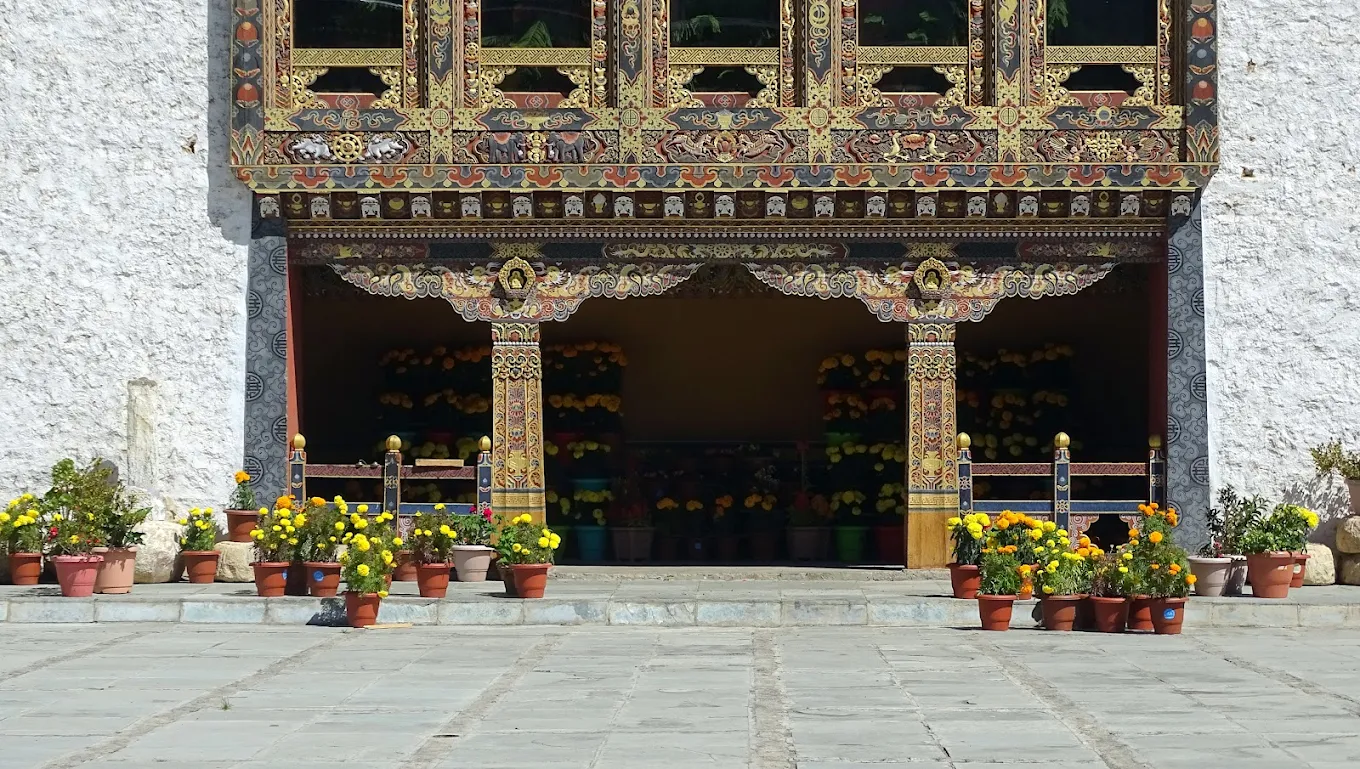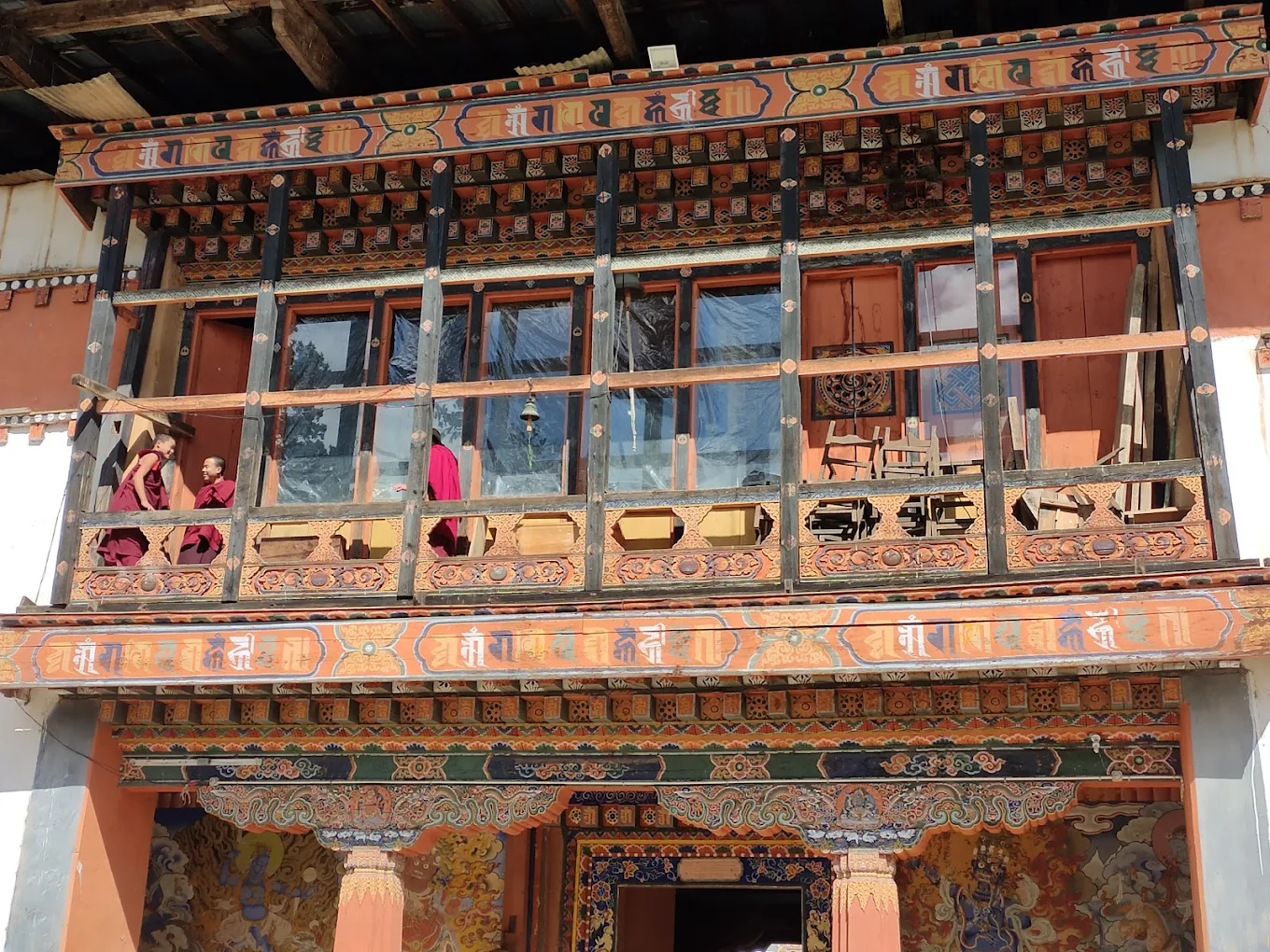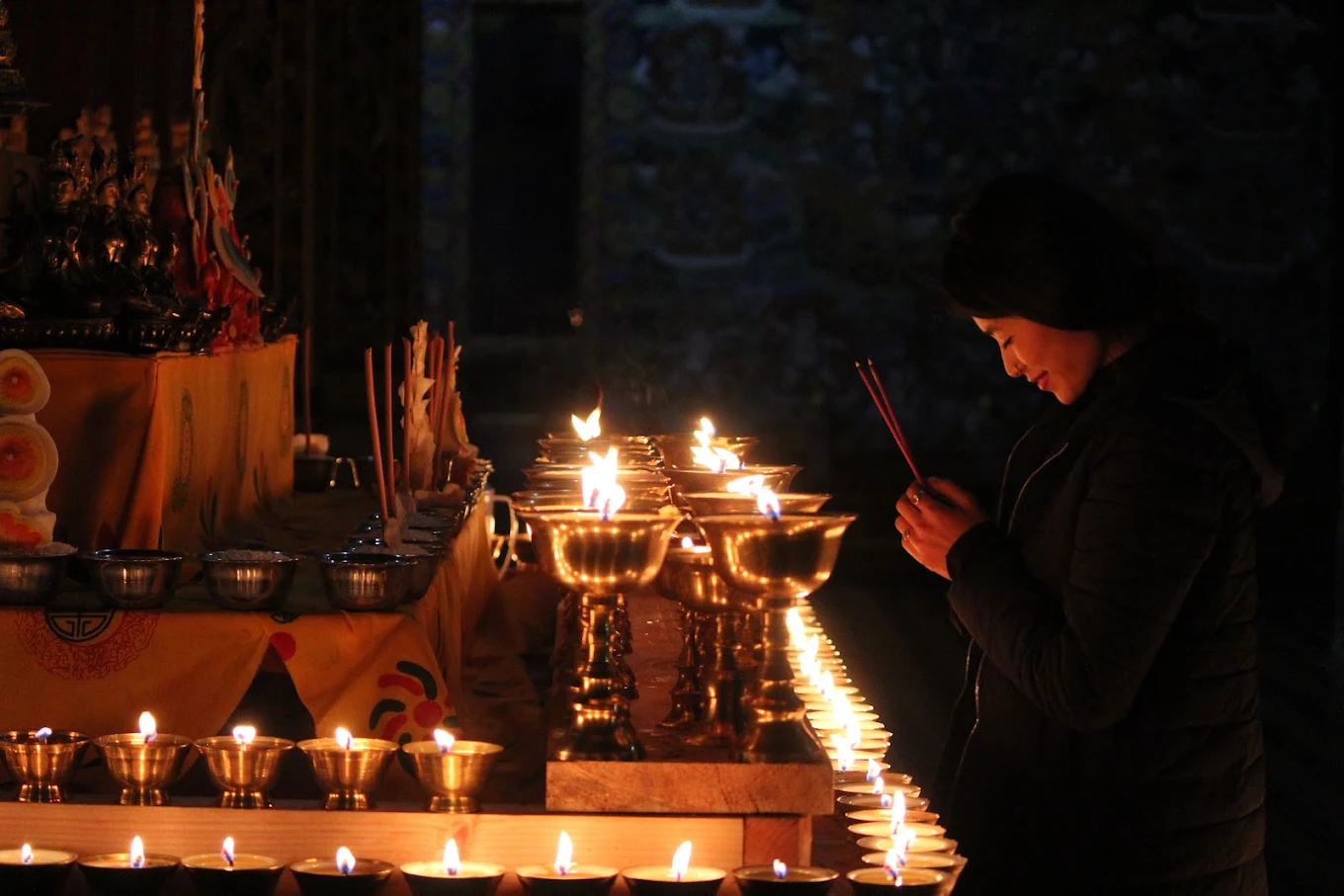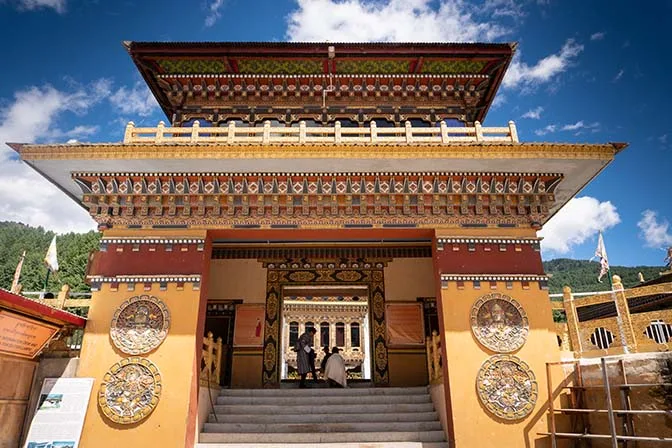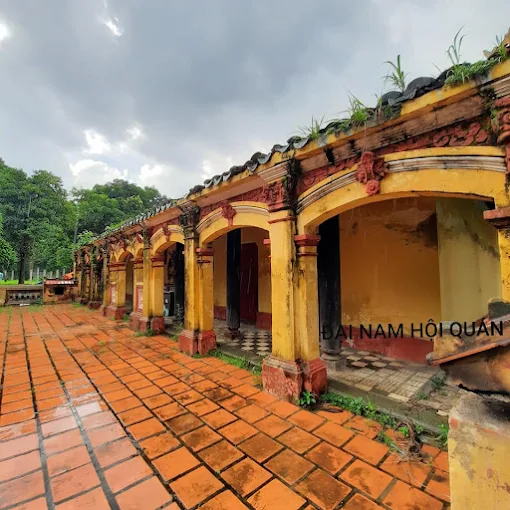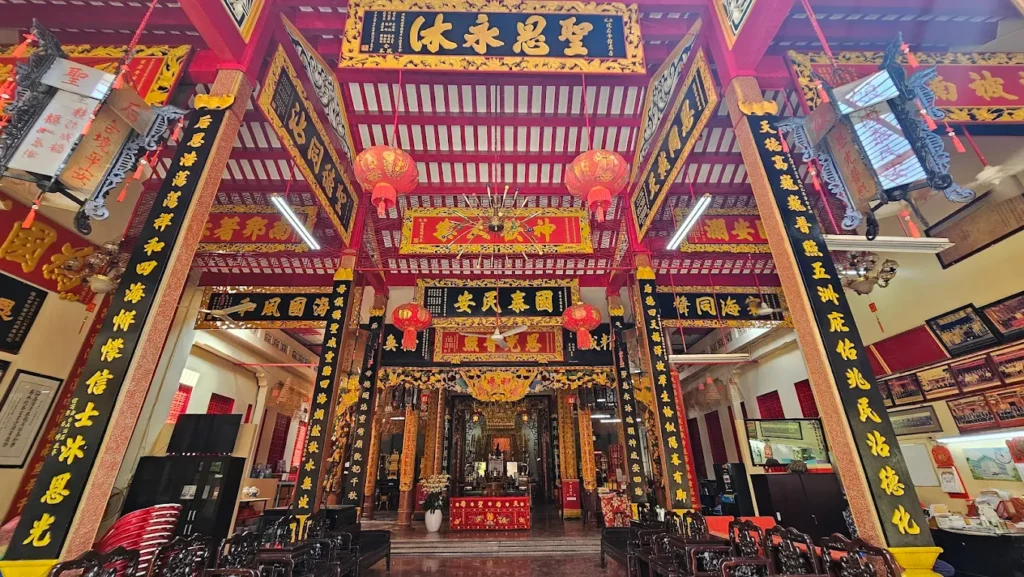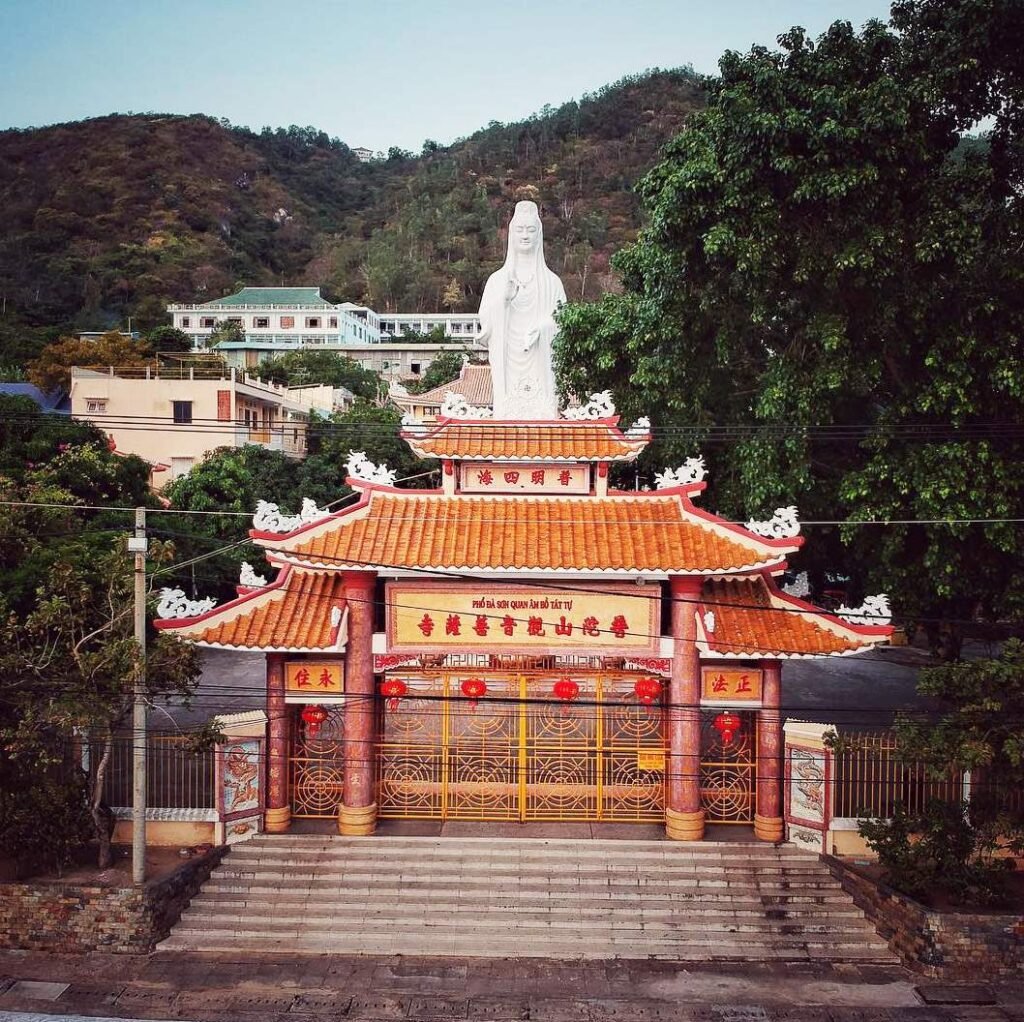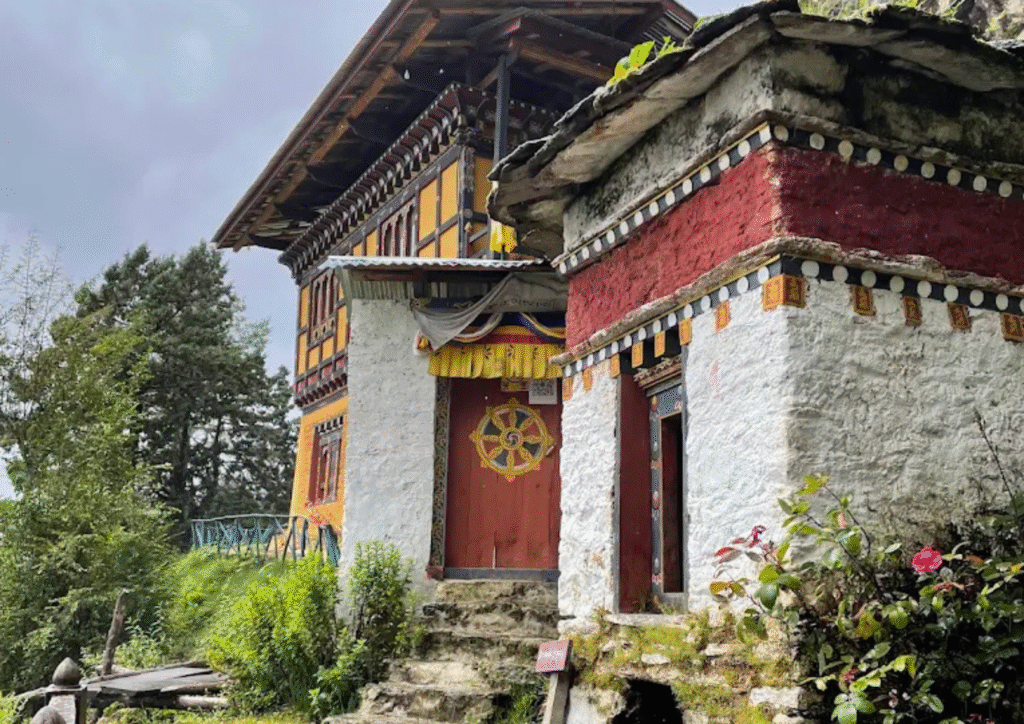Könchogsum Lhakhang: The Resilient Nyingma Jewel of Bumthang’s Spiritual Legacy
Rising with quiet resilience on a gentle hill near Jakar town, where the morning mist weaves through a landscape of terraced fields, Könchogsum Lhakhang stands as a beacon of spiritual endurance, its brightly painted walls catching the dawn’s soft light. Within the sacred main temple (lhakhang), monks chant the Om Mani Padme Hum mantra, their voices resonating around a statue of Vairocana, symbolizing the three jewels of Buddhism. Established as one of the 108 border-taming temples by Tibetan King Songtsen Gampo in the 7th century, this Nyingma site is celebrated for its restoration after a devastating fire in 2010. The air carries the scent of juniper incense, lit during prayer sessions, while prayer flags flutter against the breeze, blessing the valley below. From its hillside perch in Bumthang Dzongkhag, the sweeping vista of Chokhor Valley unfolds, connecting the lhakhang to Bhutan’s spiritual heart. This sacred retreat invites travelers, seekers, and scholars to explore its paths and immerse themselves in the enduring wisdom of Nyingma devotion.
Whispers of the Three Jewels: Overview and Significance
Introduction to Könchogsum Lhakhang
Könchogsum Lhakhang, located on a hill near Jakar town in Bumthang Dzongkhag, Bhutan, stands as a revered Nyingma sanctuary, renowned for its historical role as one of the 108 temples built by Songtsen Gampo and its recent restoration. A short walk from the Jakar-Dakarla road reveals a tranquil retreat where the rustle of fields and the sound of monastic chants create a peaceful ambiance. Founded in the 7th century and later rediscovered by Pema Lingpa in the late 15th century, it embodies Bhutan’s Nyingma heritage, blending meditation with cultural resilience. A spiritual and historical landmark, the lhakhang weaves history, restoration, and Himalayan reverence into a timeless refuge.
Historical Journey
Könchogsum Lhakhang’s history traces back to the 7th century, when Tibetan King Songtsen Gampo, following Guru Rinpoche’s guidance, built it as one of the 108 temples to subdue a demoness and propagate Buddhism across the Himalayas. The original structure remained obscure until the late 15th century, when Pema Lingpa, a tertön, rediscovered and renovated it, adding statues and paintings. A significant fire in February 2010 severely damaged the temple, but the sacred relics, including the Vairocana statue, survived. The new temple and monastery were consecrated in November 2014, rebuilt with community and government support, preserving its role as a pilgrimage site.
Cultural Significance
- Nyingma Devotion: Rooted in the Nyingma school, the lhakhang venerates Vairocana, Guru Rinpoche, and Avalokiteshvara, emphasizing Dzogchen meditation and historical sanctity.
- Bhutanese Heritage: A spiritual anchor, it preserves rituals like mantra recitation and circumambulation, reflecting national identity.
- Pilgrimage Legacy: Its status as a border-taming temple enhances its sacred role.
- Regional Influence: Pilgrimages draw devotees from Bumthang and central Bhutan, fostering community ties.
Unique Legacy
- Hillside Perch: Its location near Jakar distinguishes it among Bhutan’s temples.
- Border-Taming History: One of the 108 temples holds sacred potency, a verified cultural narrative.
- Restoration Resilience: The 2014 rebuild reflects Bhutanese dedication.
- Cultural Symbol: Its three-jewel theme mirrors Bhutan’s spiritual depth.
Community and Global Impact
- Local Devotion: The lhakhang hosts prayers and festivals, strengthening Bumthang’s Nyingma ties.
- Pilgrimage Hub: Visitors are drawn by the restored temple and historical significance.
- Global Appeal: International meditators seek its spiritual and architectural allure.
- Cultural Dialogue: Shared rituals unite Bhutanese and global visitors.
Modern Relevance
- Spiritual Retreat: Könchogsum offers a haven for mindfulness in its hillside setting.
- Cultural Preservation: It safeguards Nyingma practices, ensuring Bhutan’s heritage endures.
- Pilgrimage Influence: The restoration attracts global spiritual seekers.
Historical Anecdotes
- Songtsen’s Vision: His 7th-century founding sanctified the site.
- Pema’s Rediscovery: The late 15th-century renovation marked a cultural milestone.
- Fire Resilience: The 2010–2014 restoration showcases community spirit.
Social Role
- Community Hub: Prayers unite Bumthang’s Buddhists.
- Pilgrimage Center: Monks guide devotees in temple rituals.
- Charitable Spirit: Communal support reflects Nyingma compassion.
Artistic Influence
- Thangka Art: Murals of Vairocana inspire Bhutanese artists.
- Cultural Icon: The Chokhor view graces local imagery.
- Festival Art: Prayer flags showcase Bhutanese craftsmanship.
Könchogsum Lhakhang’s hillside perch, where Songtsen Gampo once subdued a demoness, weaves a narrative of devotion and resilience that defines Bhutan’s Nyingma heritage. From its 7th-century origins to its role as a restored pilgrimage site, the lhakhang’s history resonates with the tranquility of Chokhor Valley, uniting monks and pilgrims. Its sacred halls and scenic trails set the stage for an architectural tapestry that mirrors its Himalayan soul. As we delve into its physical and spiritual features, Könchogsum’s design reveals how its resilient beauty nurtures profound faith and cultural preservation.
Crafted by the Hill: Architectural and Spiritual Features
Iconic Design
Könchogsum Lhakhang’s architecture blends Nyingma simplicity with its hillside setting, creating a sanctuary that harmonizes with Bumthang’s terraced landscape. Brightly painted stone walls and a two-story structure, adorned with prayer flags, rise from the hill near Jakar, reflecting Bhutanese vibrancy. The rectangular layout, centered on the main lhakhang, prioritizes ceremonial function, with courtyards fostering pilgrimage. Its perch above Chokhor Valley enhances its sacred resonance, tying the lhakhang to Bhutan’s Himalayan ethos.
Key Structures
- Main Lhakhang: The spiritual core, housing Vairocana’s statue, rebuilt in 2014.
- Old Temple Interior: Encloses the original 7th-century structure, preserved post-fire.
- Chorten Courtyard: A small area with prayer wheels, used during rituals.
- Prayer Flag Poles: Structures strung with flags, dotting the hill.
Worshipped Statues
- Vairocana: A bronze statue, symbolizing the three jewels, radiates spiritual light.
- Guru Rinpoche (Padmasambhava): A statue, embodying guidance, stands prominently.
- Avalokiteshvara: A statue representing compassion, flanks the altar.
- Spiritual Role: Monks offer butter lamps to Vairocana, seeking enlightenment.
Materials and Techniques
- Construction: Stone and timber, joined with traditional methods, ensure durability.
- Artistry: Murals and mandalas, painted with mineral dyes, reflect Nyingma style.
- Cultural Essence: The design prioritizes pilgrimage resilience, distinct from dzongs.
Signature Elements
- Restored Temple: The 2014 structure anchors the spiritual narrative.
- Hillside Perch: The Jakar hill offers a serene setting.
- Prayer Flags: Fluttering flags carry blessings across the valley.
Lesser-Known Features
- Ancient Bell: A cracked relic from the 7th century, preserved upstairs.
- Mandala Ceiling: Intricate paintings survived the fire, a cultural treasure.
- Old Prayer Wheel: A weathered mani wheel, in use since the 15th century.
Preservation Efforts
- Restoration (2010–2014): Rebuilt after the fire with community support.
- Challenges: Hill erosion affects stonework, requiring maintenance.
- Modern Additions: Solar lights enhance evening accessibility.
Environmental Integration
- Hill Harmony: The lhakhang’s design respects Bumthang’s ecosystem.
- Eco-Practices: Monks maintain grounds and protect fields.
- Wildlife Haven: Birds nest nearby, enhancing serenity.
Artisan Narratives
- Mural Painters: Local artists restored mandalas, preserving Nyingma art.
- Stone Masons: Craftsmen rebuilt the lhakhang, blending tradition.
- Flag Weavers: Nuns crafted prayer flags, embedding blessings.
Symbolic Details
- Prayer Flags: Five colors balance elements, spreading dharma.
- Mandala Art: Represents cosmic order, guiding pilgrims.
- Statues: Reflect Nyingma wisdom and compassion.
Landscape Integration
- Hillside Perch: Enhances meditative focus with valley views.
- Chokhor Vista: The valley mirrors inner peace.
- Terraced Fields: Provide solitude and spiritual resonance.
Könchogsum Lhakhang’s stone lhakhang and sacred courtyards, overlooking Chokhor Valley, are more than architectural marvels; they are sanctuaries for the Nyingma practices that define its spiritual soul. The statue of Vairocana, illuminated by butter lamps, anchors rituals that connect monks to Bhutan’s spiritual lineage. These hallowed spaces, alive with chants and restored relics, invite visitors to engage with the lhakhang’s living traditions. As we explore its rituals, Könchogsum’s role as a meditative and resilient retreat comes to life, guiding devotees toward enlightenment and cultural continuity.
Rites of Resilience: Rituals and Practices
Daily Sacred Rites
- Morning Chanting: Monks recite the Om Mani Padme Hum mantra at dawn, fostering compassion.
- Meditation Sessions: Silent meditation, held twice daily, centers on Dzogchen practices.
- Butter Lamp Offerings: Devotees light lamps before Vairocana, praying for wisdom.
Unique Practices
- Mural Meditation: Monks meditate before Pema Lingpa’s paintings, a Nyingma tradition.
- Circumambulation Ritual: Pilgrims circle the lhakhang, seeking merit post-restoration.
- Signature Ritual: Offering khata scarves during circumambulation, tied to renewal.
Festival Traditions
- Könchogsum Tshechu (dates vary): A local festival with prayers and circumambulation.
- Lhabab Duchen: Ceremonies honor the Buddha’s descent, with chorten circuits.
- Losar (Bhutanese New Year): Monks perform purification rites, blessing visitors.
- Statue Veneration: Vairocana’s statue is adorned with silk during festivals.
Visitor Engagement
- Accessible Rituals: Visitors can join chants or circumambulate, guided by monks.
- Offerings: Butter lamps and prayer flags, available at the lhakhang, invite participation.
- Nyingma Etiquette: Bow before statues and maintain silence during meditation.
Spiritual Community Roles
- Monastics: Around 20–30 monks maintain the site and lead rituals.
- Lamas: Senior monks guide mural preservation and pujas.
- Lay Devotees: Bumthang villagers maintain grounds and support festivals.
Interfaith Connections
- Syncretic Practices: Some blend Nyingma rites with local traditions, honoring spirits.
- Outreach: Festivals welcome diverse faiths, fostering unity.
- Education: Monks share Nyingma teachings with visitors.
Ritual Symbolism
- Butter Lamps: Represent wisdom illuminating resilience.
- Khata Offerings: Symbolize purity and devotion.
- Circumambulation: Signifies renewal after the fire.
Seasonal Variations
- Spring Rites: Vibrant with valley blooms, ideal for Könchogsum Tshechu.
- Winter Retreats: Cold enhances meditation focus.
- Monsoon Chants: Rain amplifies mantra resonance.
Monastic Life
- Daily Routine: Monks rise at 5:00 AM for chants, meditation, and maintenance.
- Community Service: Monks guide pilgrims and protect the lhakhang.
- Training Hub: Monks learn Nyingma philosophy, supporting Bumthang’s faith.
Könchogsum Lhakhang’s rituals, from the Om Mani Padme Hum mantra to circumambulation, breathe life into its hillside sanctuary, connecting devotees to the Nyingma lineage. The lhakhang’s spiritual practices, rooted in Bhutan’s resilient faith, invite visitors to engage with its sacred heart, whether through chants or restored rituals. For travelers, these rites offer a glimpse into Bumthang’s sacred traditions, accessible within its valley grounds. As we turn to visitor information, Könchogsum’s hillside setting guides practical planning, ensuring a meaningful journey to this restored retreat.
Journey to the Hill: Visitor Information
Navigating to Könchogsum Lhakhang
- Location: Bumthang Dzongkhag, near Jakar town, accessible via a trail from the Jakar-Dakarla road.
- Landmarks: Near the Chokhor Valley and Jakar Dzong, with Dzongkha and English signs.
- Routes: Walk from Jakar (10–15 minutes) or drive to the hill base.
Address of Könchogsum Lhakhang
- Dzongkha: Könchogsum Lhakhang, Bumthang Dzongkhag, Bhutan.
- English: Könchogsum Lhakhang, Bumthang District, Bhutan.
Visiting Hours and Etiquette
- Hours: Open daily, 6:00 AM–6:00 PM, with ceremonies varying by schedule.
- Etiquette: Dress modestly, remove shoes before lhakhang, and avoid disturbing rituals.
- Nyingma Custom: Offer butter lamps with both hands and bow to statues.
Transport Options
- By Foot: Walk from Jakar (10–15 minutes, easy difficulty).
- By Vehicle: Drive to the hill access point, then walk.
- By Bicycle: A scenic ride suits active visitors to the base.
Accessibility and Safety
- Mobility: Gentle slopes may challenge those with mobility issues; no ramps available.
- Safety: Stable paths with guideposts; carry water for the walk.
- Tips: Wear comfortable shoes and bring layers for weather changes.
Amenities and Surroundings
- Facilities: Basic restrooms near the lhakhang; no shops on-site.
- Nearby: Jakar Dzong and Kurje Lhakhang, within 2–5 km, offer cultural experiences.
- Dining: Picnic areas encourage packed meals, with options in Jakar.
Immersive Visitor Tips
- Best Timing: Early morning visits offer quiet chants and cooler weather.
- Sensory Moments: Inhale field-scented air and hear valley echoes.
- Statue Connection: Offer butter lamps to Vairocana and reflect briefly.
- Festival Planning: Attend Könchogsum Tshechu for circumambulation.
Nearby Cultural Experiences
- Jakar Dzong: A historic fortress, 2 km away, blends spirituality and defense.
- Kurje Lhakhang: An ancient temple, 5 km away, holds Guru Rinpoche’s imprint.
- Jambay Lhakhang: A 7th-century site, 3 km away, offers sacred relics.
Photography Tips
- Best Angles: Capture the lhakhang at sunrise for golden light.
- Respectful Shots: Avoid photographing rituals without permission.
- Scenic Views: The Chokhor Valley offers stunning vistas.
- Equipment: A smartphone or lightweight camera suffices.
The journey to Könchogsum Lhakhang, guided by Bumthang’s hillside trails, is a pilgrimage that blends spiritual discovery with cultural resilience, inviting visitors to engage with its Nyingma traditions. The lhakhang’s halls and courtyards, vibrant with chants and restored relics, offer a window into Bhutan’s sacred heart, where endurance feels palpable. Beyond its hillside beauty, Könchogsum’s deeper cultural and spiritual significance enriches the experience, revealing the essence of Himalayan Buddhism. As we explore these insights, the lhakhang’s role as a beacon of faith and restoration comes into sharper focus, deepening our connection to its sacred legacy.
Insights of the Hill: Cultural and Spiritual Reflections
Nyingma Philosophy
Könchogsum Lhakhang embodies Nyingma’s core: compassion and wisdom through Dzogchen meditation and historical sanctity. Vairocana, Guru Rinpoche, and Avalokiteshvara inspire devotees, reflected in chants and circumambulation. Mahamudra teachings emphasize direct realization, guiding monks toward enlightenment.
Environmental Spirituality
The lhakhang’s hillside perch ties it to Himalayan reverence for nature. Chokhor’s fields and valley views foster meditative calm, with offerings honoring local spirits. The landscape invites reflection on harmony with the natural world.
Artistic Symbolism
Murals depict Vairocana’s light, symbolizing the three jewels. The mandala ceiling represents cosmic order, while prayer flags balance elements. These elements weave Nyingma ideals into the lhakhang’s aesthetic.
Community Resilience
Founded by Songtsen Gampo’s followers and rediscovered by Pema Lingpa, Könchogsum reflects Bhutanese perseverance through time. Its 2014 restoration showcases collective faith, sustained by community efforts.
Environmental Stewardship
The lhakhang’s slopes foster Buddhist eco-ethics. Monks protect trails and fields, urging visitors to honor the hill’s sanctity.
Meditative Practices
Nyingma meditation, including Dzogchen, cultivates awareness. The lhakhang offers spaces for retreat, guided by monks, amplifying inner peace.
Cultural Narratives
- Songtsen’s Legacy: His 7th-century founding inspires devotion.
- Pema’s Rediscovery: The 15th-century renovation links past and present.
- Festival Lore: Könchogsum Tshechu carries Nyingma traditions.
Historical Context
- Nyingma Roots: Songtsen Gampo’s 7th-century vision shaped its identity.
- Pema’s Era: The 15th-century rediscovery strengthened its role.
- Community Continuity: The 2014 rebuild ensures its legacy.
Reflecting on the Journey
Könchogsum Lhakhang, cradled on Bumthang’s sacred hill, is a sanctuary where resilience meets wisdom. Its lhakhang and courtyards, alive with Vairocana’s legacy, embody Bhutan’s Nyingma soul, inviting all to seek enlightenment. The lhakhang’s trails, worn by centuries of pilgrims, tell a story of devotion, rooted in Himalayan faith. Whether meditating before Guru Rinpoche, circumambulating the restored temple, or tracing Bhutan’s border-taming heritage, visitors find a space to reflect and connect. As you depart, the field scent and prayer flags’ flutter linger, a reminder that peace is always within reach.
